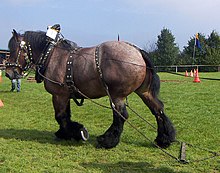
The Percheron is a breed of draft horse that originated in the Huisne river valley in western France, part of the former Perche province, from which the breed takes its name. Usually gray or black in color, Percherons are well-muscled, and known for their intelligence and willingness to work. Although their exact origins are unknown, the ancestors of the breed were present in the valley by the 17th century. They are believed to descend from war horses. Over time, they began to be used for pulling stagecoaches; and later, for agriculture and hauling heavy goods. In the late 18th and early 19th centuries, Arabian blood was added to the breed. Exports of Percherons from France rose exponentially in the late 19th century, and the first purely Percheron stud book was created in France in 1893.
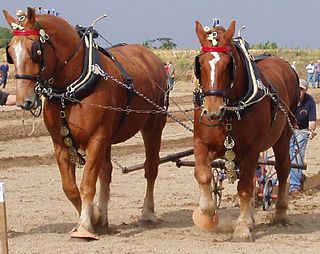
The Suffolk Horse, also historically known as the Suffolk Punch or Suffolk Sorrel, is an English breed of draught horse. The first part of the name is from the county of Suffolk in East Anglia, and the word "Punch" is an old English word for a short stout person. It is a heavy draught horse which is always chestnut in colour, traditionally spelled "chesnut". Suffolk Punches are known as good doers, and tend to have energetic gaits.

The Cleveland Bay is a breed of horse that originated in England during the 17th century, named after its colouring and the Cleveland district of Yorkshire. It is a well-muscled horse, with legs that are strong but short in relation to the body. The horses are always bay in colour, although a few light hairs in the mane and tail are characteristic of some breed lines. It is the oldest established horse breed in England. The ancestors of the breed were developed during the Middle Ages for use as pack horses, when they gained their nickname of "Chapman Horses". These pack horses were cross-bred with Andalusian and Barb blood, and later with Arabians and Thoroughbreds, to create the Cleveland Bay of today. Over the years, the breed became lighter in frame as they were employed more as carriage and riding horses. The popularity of the Cleveland Bay has greatly fluctuated since it was first imported to the United States in the early nineteenth century. Despite serious declines in the population after the Second World War, the breed has experienced a resurgence in popularity since the 1970s, although only around 550 horses existed worldwide as of 2006.

The Russian Don is a breed of horse developed in and named after the steppes region of Russia where the Don River flows. Utilized originally as cavalry horses for the Cossacks, they are currently used for under-saddle work and driving.
The Galiceno is a horse breed developed in Mexico, bred from horses brought from Spain by Hernán Cortés and other conquistadors. Although small in stature, they are generally considered a horse, rather than a pony, and are always solid-colored. In Mexico, they are an all-around horse, used for riding, packing and light draft. In the United States they are often used as mounts for younger competitors, although they are also found competing in Western events. The breed descends from horses brought from Spain to Mexico during the 16th century. Many of these horses escaped or were released and formed feral bands in the interior of Mexico, which were then captured by local inhabitants. They were also often used by Spanish missionaries to the American West, where they became some of the ancestors of the American Indian Horse. In 1958, these horses were first imported to the United States, and in 1959 a breed registry was formed. Many of the horses are also registered with the American Indian Horse Registry.
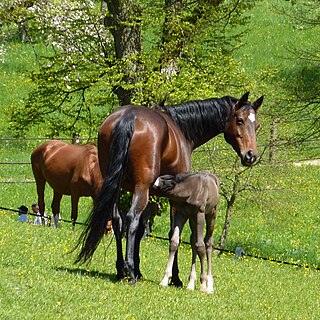
The Württemberger, Baden-Württemberger or Württemberg is a Warmblood horse breed originating in Germany. They are primarily riding horses, and are selectively bred for dressage and show jumping.

The Boulonnais, also known as the "White Marble Horse", is a draft horse breed. It is known for its large but elegant appearance and is usually gray, although chestnut and black are also allowed by the French breed registry. Originally there were several sub-types, but they were crossbred until only one is seen today. The breed's origins trace to a period before the Crusades and, during the 17th century, Spanish Barb, Arabian, and Andalusian blood were added to create the modern type.

The Maremmano is a breed of horse originating in the Maremma area of Tuscany and northern Lazio in Italy. Traditionally a hardy working horse used by the Butteri for livestock management, it is today principally a saddle horse. Extensive crossing with Thoroughbred and other breeds has led to a more athletic type, the Maremmano migliorato, or "Improved Maremmano".
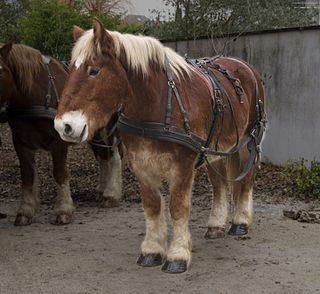
The Trait Breton is a French breed of draught horse. It originated in Brittany, in north-west France, from cross-breeding of local horses with various other breeds. It is strong and muscular, and often has a chestnut coat.
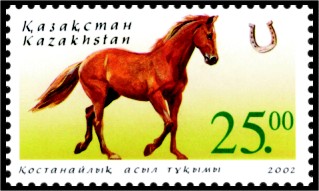
The Kustanair is a breed of horse developed in Kazakhstan in the former U.S.S.R. in the late 19th and early 20th centuries. They are used mainly for under-saddle and light draft work.

The Lithuanian Heavy Draught is a draught horse breed created in Lithuania during the 19th and 20th centuries. They are used mainly for heavy draught and farm work, as well as meat production and the improvement of other breeds. The breed is currently near extinction..

The Auxois is a horse breed from eastern France. It is a large breed, with some individuals weighing over 910 kilograms (2,010 lb), bred for horse meat, agricultural work and leisure pursuits. Overall, members of the breed are solid and muscular in appearance. They are usually bay or bay roan in color, although some other colors are accepted by the breed registry, and are known for their power and docility.

The Jutland horse is a draft horse breed originating in Denmark, named after the Jutland Peninsula which forms the western part of the country. Usually chestnut, they are a compact, muscular breed known for their calm and willing temperament. The breed was originally developed for use in agriculture, but today is more often seen in urban settings and at horse shows. Some of the best known members of the breed pull beer wagons for the Carlsberg brewery around Copenhagen, as well as at competitions and for demonstrations. Images from the 9th century show a horse similar to the Jutland being used by Viking raiders in what is now Great Britain. The first written record is from the 12th century, when they were popular as war horses. Some infusion of bloodlines from other breeds occurred in the 18th century, but the modern Jutland type only began about 1850 with the addition of blood from several other breeds, mainly draft horses. A stud book was created in the late 19th century, and the Jutland population grew to a maximum around 15,000 by 1950. Numbers subsequently declined, and as of 2011, only an estimated 1,000 horses remained.

The Soviet Heavy Draft is a Russian breed of heavy draft horse. It derives from the Belgian Brabant heavy draft breed. It was developed in the former Soviet Union for agricultural draft work, and was recognized as a breed in 1952. It is one of several heavy draft breeds developed in the Soviet Union in the twentieth century, others being the Russian Heavy Draft – which derived mainly from the Ardennais – and the Vladimir Heavy Draft, which was derived principally from the Clydesdale.

The Trait du Nord, previously also known as Ardennais du Nord or Ardennais de type Nord, is a breed of heavy draft horse developed and bred in the area of Hainaut in western Belgium and in northeastern France. Originally considered a subtype of the Ardennes, it was recognized as an individual breed with the opening of a studbook in 1903. Developed in the fertile Flemish grasslands, it was bred for size and pulling power for agricultural work. By 1855, the horses bred near Hainaut were considered by some veterinarians to be superior to other Flemish draft breeds. The Trait du Nord was used extensively in mining from the late 19th century through 1920, with lesser use continuing through the 1960s.

The Italian Heavy Draft, or Rapid Heavy Draft, is a breed of draft horse from Italy. The full Italian name of the breed is Cavallo Agricolo Italiano da Tiro Pesante Rapido, "Italian Rapid Heavy Draft Farm Horse", and the abbreviation TPR ) is often used.
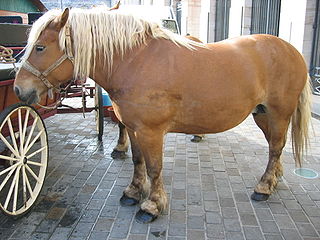
The Comtois horse is a draft horse that originated in the Jura Mountains on the border between France and Switzerland.

The Kazakh Horse is a horse breed of the Kazakh people, who live mainly in Kazakhstan, but also in parts of China, Mongolia, Russia and Uzbekistan. It is used mainly as a riding horse, and is known for its hardiness and stamina.

The Norman Cob or Cob Normand is a breed of light draught horse that originated in the region of Normandy in northern France. It is of medium size, with a range of heights and weights, due to selective breeding for a wide range of uses. Its conformation is similar to a robust Thoroughbred, and it more closely resembles a Thoroughbred cross than other French draught breeds. The breed is known for its lively, long-striding trot. Common colours include chestnut, bay and seal brown. There are three general subsets within the breed: horses used under saddle, those used in harness, and those destined for meat production. It is popular for recreational and competitive driving, representing France internationally in the latter, and is also used for several riding disciplines.
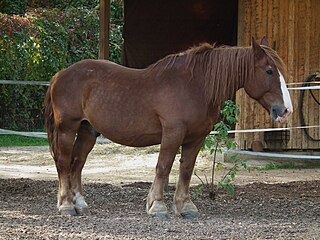
The Pfalz-ardenner is a breed of medium-sized draft horse from the German state of Rhineland-Palatinate. As its name implies, it derives from the cross-border Ardennais breed, based on crossings between French, Belgian, and, to a lesser extent, Bavarian draft horses. Its studbook was created in 1906 and accepted numerous crosses from the beginning. Motorized farming threatened to exterminate the breed in the 1970s.


